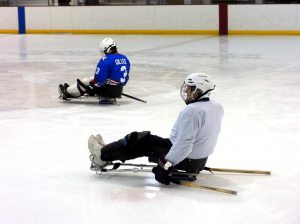A couple dozen hockey players left the ice on Jan. 5 at the Town of Oyster Bay Rink in Bethpage, trudging to the locker room to take off their skates. A new wave of skate-less athletes filed in and unpacked their sleds, ready for some ice time of their own.
Informal salutations joyfully echoed in the rink as Long Island Sled Hockey Inc. officially conquered the space. The boys and girls as young as 9 years old to grown men in their 60s, each with a physical or mental disability of some kind, prepared in haste for the bi-weekly hour-long practice that transports them to a place void of limitations.
“It’s very uplifting,” said Nick Capparelli, 63, an Oceanside resident with amyotrophic lateral sclerosis (ALS). “When you’re on the ice, you forget that you’re handicapped.”
The Long Island RoughRiders are not just a sled hockey team that competes against other squads in the U.S. and Canada, but a family that started with 16 members and now has about 50, each with their own story.
Christopher Bustamante, who served in the army from 2009 to 2014, took a fall during redeployment and suffered a spinal injury as a result. “Everybody here has their challenges and it’s interesting to see that when you get on the ice, they’ve overcome those challenges because out here there’s not a disability,” Bustamante said. “There’s that feeling of camaraderie that I had when I was in the military and these guys, they bring it all back for me and it’s really nice to be part of that.”




While some become “differently abled” later in life, others are born that way. Merrick resident Dan Santos has dealt with femoral hypoplasia his whole life, a syndrome in which you are born with small femurs.
“I always wanted to play hockey when I was growing up [but] didn’t really know how I could possibly do it with crutches walking around,” said Santos. “I found sled hockey and it’s been awesome ever since.”
Invented in Sweden in the 1960s, the game was meant for those with disabilities who wanted to play hockey. With six men on each side, the sport that has become one of the most popular at the Paralympic Games and has many of the same rules as hockey. Each player is sitting on what is known as a sledge. To move on the ice, they have short sticks in each hand with blades that can dig into the ice to help propel them.
The team has won 14 tournament titles, four silver medals and seven bronze medals since 2003 when Bryan Blomquist, 66, volunteered to take over as coach. The RoughRiders have traveled to Albany, Massachusetts, Florida and Ottawa, Canada to compete and will embark on a trip to the London Blizzard Invitational in London, Ontario on Jan. 21. Long Island Sled Hockey also hosts the RoughRiders Cup and challenges varsity hockey teams to get in sleds and play them, including the Cadets at the United States Military Academy in front of a large West Point crowd every November.
Instead of turning away mentally disabled players, Blomquist said he thinks the RoughRiders are the only nonprofit in the country in which the mentally handicapped make up about 25 percent of the program.
The growing number of members meant last year’s costs eclipsed $350,000, but those expenses never make it to the athletes. Blomquist’s fundraising efforts—including a golf outing, a months-long television raffle and the “50s Sock Hop” dance—pull in most of the money, and two months ago, Blomquist announced at the major November benefit that he had raised $258,000 in 2015. His first year, he raised $14,000, which shows just how far the program has come.
“It’s not me, it’s them,” Blomquist said. “They sell the program. All I ask people, come down and watch them for five minutes, but I want you to come for the last five minutes because I want you to see them get off the ice. This guy’s strapping on a leg, this guy is strapping on two. Eight guys are in wheelchairs…watch when they come off [the ice]. They’re all smiling.”



























